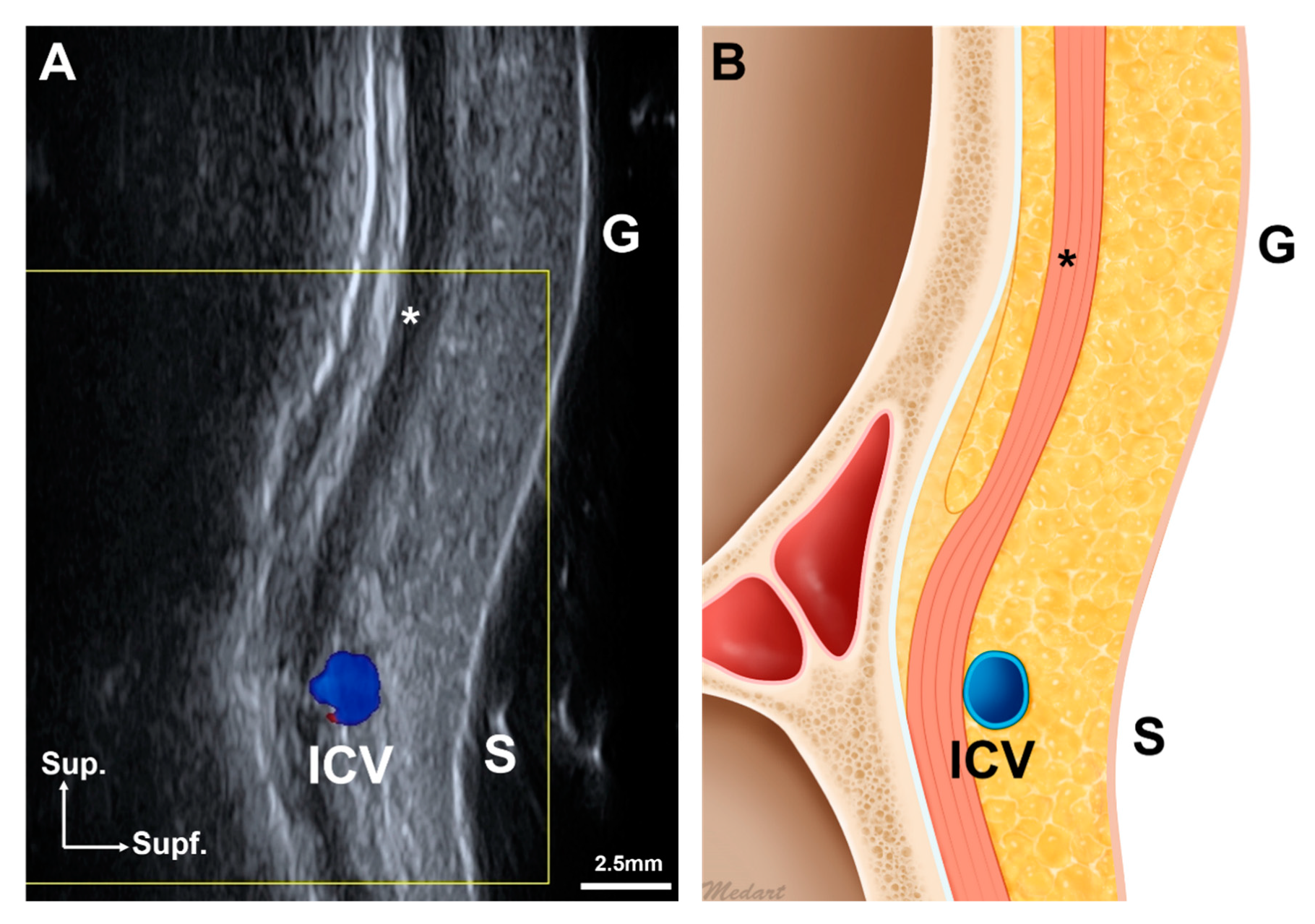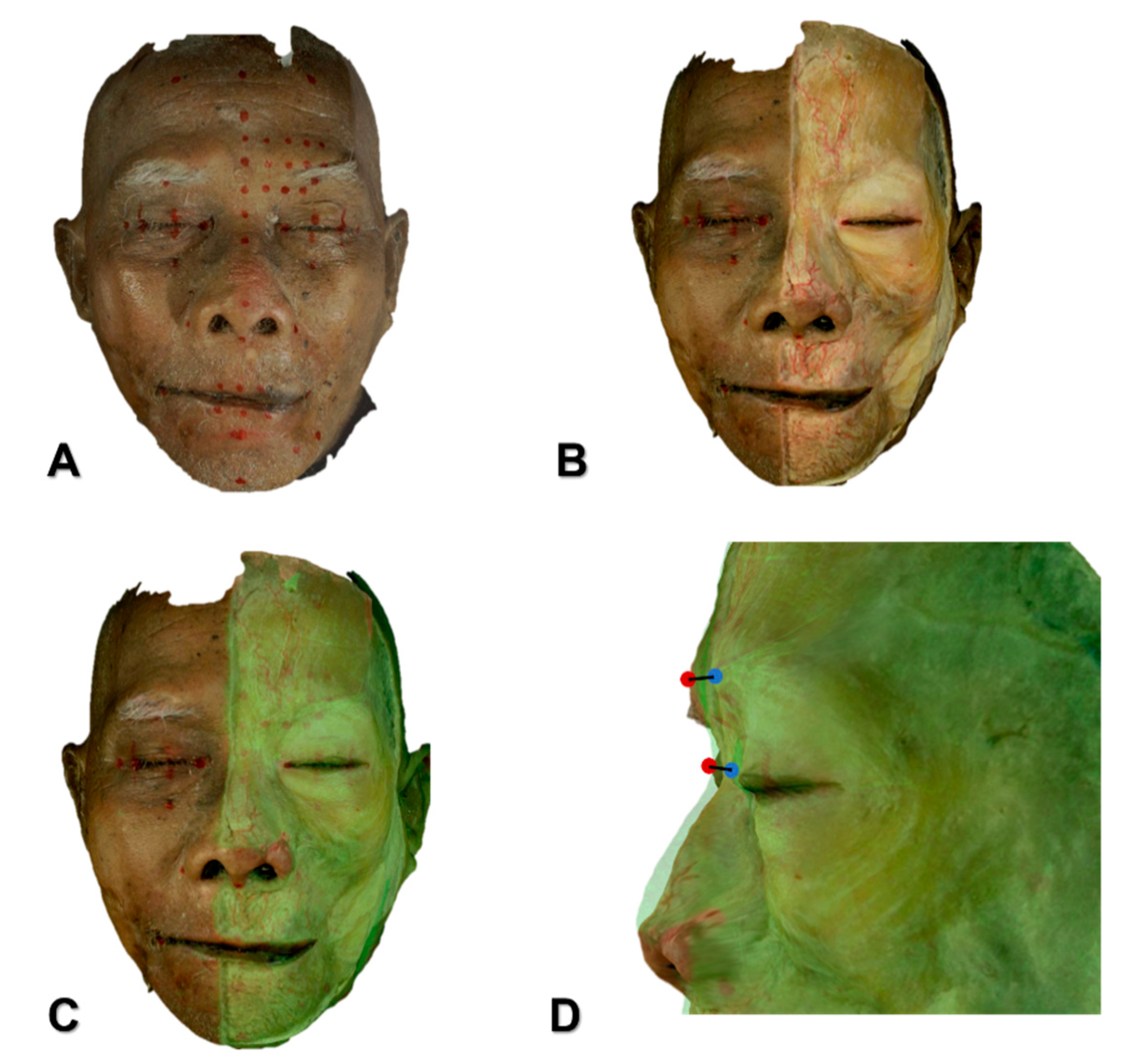Ultrasonographic and Three-Dimensional Analyses at the Glabella and Radix of the Nose for Botulinum Neurotoxin Injection Procedures into the Procerus Muscle
Abstract
:1. Introduction
2. Results
3. Discussion
4. Conclusions
5. Materials and Methods
5.1. 3D Scanning Using a Structured-Light Scanner for Analyzing the Depth of the Procerus
5.2. US Analyses of the Procerus and the ICV
5.3. Statistical Analysis
Author Contributions
Funding
Conflicts of Interest
References
- Alster, T.S.; Lupton, J.R. Botulinum toxin type B for dynamic glabellar rhytides refractory to botulinum toxin type A. Dermatol. Surg. Off. Publ. Am. Soc. Dermatol. Surg. 2003, 29, 516–518. [Google Scholar]
- Carruthers, J.D.; Lowe, N.J.; Menter, M.A.; Gibson, J.; Eadie, N.; Botox Glabellar Lines, I.I.S.G. Double-blind, placebo-controlled study of the safety and efficacy of botulinum toxin type A for patients with glabellar lines. Plast. Reconstr. Surg. 2003, 112, 1089–1098. [Google Scholar] [CrossRef] [PubMed]
- Frampton, J.E.; Easthope, S.E. Botulinum toxin A (Botox Cosmetic): A review of its use in the treatment of glabellar frown lines. Am. J. Clin. Dermatol. 2003, 4, 709–725. [Google Scholar] [CrossRef] [PubMed]
- Brown, T.M.; Krishnamurthy, K. Anatomy, Head and Neck, Procerus Muscle; StatPearls: Treasure Island, FL, USA, 2019. [Google Scholar]
- Hur, M.S. Anatomical relationships of the procerus with the nasal ala and the nasal muscles: Transverse part of the nasalis and levator labii superioris alaeque nasi. Surg. Radiol. Anat. 2017, 39, 865–869. [Google Scholar] [CrossRef] [PubMed]
- Carruthers, A.; Carruthers, J. Eyebrow height after botulinum toxin type A to the glabella. Dermatol. Surg. Off. Publ. Am. Soc. Dermatol. Surg. 2007, 33, S26–S31. [Google Scholar] [CrossRef]
- Jiang, H.; Zhou, J.; Chen, S. Different Glabellar Contraction Patterns in Chinese and Efficacy of Botulinum Toxin Type A for Treating Glabellar Lines: A Pilot Study. Dermatol. Surg. Off. Publ. Am. Soc. Dermatol. Surg. 2017, 43, 692–697. [Google Scholar] [CrossRef]
- Kamat, A.; Quadros, T. An observational study on glabellar wrinkle patterns in Indians. Indian J. Derm. Venereol Leprol 2019, 85, 182–189. [Google Scholar] [CrossRef]
- Hwang, K.; Jin, S.; Park, J.H.; Chung, I.H. Innervation of the procerus muscle. J. Craniofacial Surg. 2006, 17, 484–486. [Google Scholar] [CrossRef]
- Shimizu, Y.; Imanishi, N.; Nakajima, T.; Nakajima, H.; Aiso, S.; Kishi, K. Venous architecture of the glabellar to the forehead region. Clin. Anat. 2013, 26, 183–195. [Google Scholar] [CrossRef]
- Lee, H.J.; Kang, I.W.; Won, S.Y.; Lee, J.G.; Hu, K.S.; Tansatit, T.; Kim, H.J. Description of a novel anatomic venous structure in the nasoglabellar area. J. Craniofacial Surg. 2014, 25, 633–635. [Google Scholar] [CrossRef]
- Choi, K.Y.; Yang, C.J. A case report of cavernous sinus thrombosis after trauma. Int. J. Pediatr. Otorhinolaryngol. 2017, 95, 101–103. [Google Scholar] [CrossRef] [PubMed]
- Li, X.; Tronstad, L.; Olsen, I. Brain abscesses caused by oral infection. Endod. Dent. Traumatol. 1999, 15, 95–101. [Google Scholar] [CrossRef] [PubMed]
- Prochazka, V.; Cizek, V.; Kacirova, R. Cavernous sinus dural fistula treated by transvenous facial vein approach. Interv. Neuroradiol. 2004, 10, 69–74. [Google Scholar] [CrossRef] [PubMed]
- Lee, K.W.; Kim, S.H.; Gil, Y.C.; Hu, K.S.; Kim, H.J. Validity and reliability of a structured-light 3D scanner and an ultrasound imaging system for measurements of facial skin thickness. Clin. Anat. 2017, 30, 878–886. [Google Scholar] [CrossRef] [PubMed]
- Lee, H.J.; Kim, J.S.; Youn, K.H.; Lee, J.; Kim, H.J. Ultrasound-Guided Botulinum Neurotoxin Type A Injection for Correcting Asymmetrical Smiles. Aesthetic Surg. J. 2018, 38, NP130–NP134. [Google Scholar] [CrossRef] [Green Version]
- Lee, H.J.; Choi, Y.J.; Lee, K.W.; Hu, K.S.; Kim, S.T.; Kim, H.J. Ultrasonography of the internal architecture of the superficial part of the masseter muscle in vivo. Clin. Anat. 2019, 32, 446–452. [Google Scholar] [CrossRef] [PubMed]
- Koerte, I.K.; Schroeder, A.S.; Fietzek, U.M.; Borggraefe, I.; Kerscher, M.; Berweck, S.; Reiser, M.; Ertl-Wagner, B.; Heinen, F. Muscle atrophy beyond the clinical effect after a single dose of OnabotulinumtoxinA injected in the procerus muscle: A study with magnetic resonance imaging. Dermatol. Surg. Off. Publ. Am. Soc. Dermatol. Surg. 2013, 39, 761–765. [Google Scholar] [CrossRef] [PubMed]
- Lorenc, Z.P.; Smith, S.; Nestor, M.; Nelson, D.; Moradi, A. Understanding the functional anatomy of the frontalis and glabellar complex for optimal aesthetic botulinum toxin type A therapy. Aesthetic Plast. Surg. 2013, 37, 975–983. [Google Scholar] [CrossRef]
- Alimohammadi, M.; Andersson, M.; Punga, A.R. Correlation of botulinum toxin dose with neurophysiological parameters of efficacy and safety in the glabellar muscles: A double-blind, placebo-controlled, randomized study. Acta Derm. Venereol. 2014, 94, 32–37. [Google Scholar] [CrossRef]
- Alam, M.; Arndt, K.A.; Dover, J.S. Severe, intractable headache after injection with botulinum a exotoxin: Report of 5 cases. J. Am. Acad. Dermatol. 2002, 46, 62–65. [Google Scholar] [CrossRef]
- Quezada-Gaon, N.; Wortsman, X.; Penaloza, O.; Carrasco, J.E. Comparison of clinical marking and ultrasound-guided injection of Botulinum type A toxin into the masseter muscles for treating bruxism and its cosmetic effects. J. Cosmet. Dermatol. 2016, 15, 238–244. [Google Scholar] [CrossRef] [PubMed]
- Kim, H.-J.; Seo, K.K.; Lee, H.-K.; Kim, J. Clinical Anatomy for Botulinum Toxin Injection. In Clinical Anatomy of the Face for Filler and Botulinum Toxin Injection; Springer: Singapore, 2016; pp. 55–92. [Google Scholar]
- Choi, Y.J.; Lee, K.W.; Gil, Y.C.; Hu, K.S.; Kim, H.J. Ultrasonographic Analyses of the Forehead Region for Injectable Treatments. Ultrasound Med. Biol. 2019, 45, 2641–2648. [Google Scholar] [CrossRef] [PubMed] [Green Version]
- Kim, Y.S.; Lee, K.W.; Kim, J.S.; Gil, Y.C.; Tanvaa, T.; Shin, D.H.; Kim, H.J. Regional thickness of facial skin and superficial fat: Application to the minimally invasive procedures. Clin. Anat. 2019. [Google Scholar] [CrossRef] [PubMed]




| Site | Measurement Method | Depth from Skin Surface to the Procerus (mm) | p-Value |
|---|---|---|---|
| Glabella | Ultrasonography (n = 55) | 3.8 ± 0.7 | 0.144 |
| 3D scanning (n = 45) | 4.1 ± 1.3 | ||
| Sellion | Ultrasonography (n = 69) | 2.7 ± 0.6 | 0.063 |
| 3D scanning (n = 45) | 3.0 ± 1.1 |
| Site Measurement | Type I | Type II | |
|---|---|---|---|
| n = 55 (79.7%) | n = 14 (20.3%) | ||
| Glabella | Depth | 3.8 ± 0.7 mm | |
| Thickness | 1.1 ± 0.5 mm | ||
| Sellion | Depth | 2.7 ± 0.5 mm | 2.7 ± 0.9 mm |
| Thickness * | 1.6 ± 0.6 mm | 1.3 ± 0.4 mm | |
| Width | 10.1 ± 2.0 mm | 10.2 ± 1.2 mm | |
© 2019 by the authors. Licensee MDPI, Basel, Switzerland. This article is an open access article distributed under the terms and conditions of the Creative Commons Attribution (CC BY) license (http://creativecommons.org/licenses/by/4.0/).
Share and Cite
Cho, Y.; Lee, H.-J.; Lee, K.-W.; Lee, K.-L.; Kang, J.S.; Kim, H.-J. Ultrasonographic and Three-Dimensional Analyses at the Glabella and Radix of the Nose for Botulinum Neurotoxin Injection Procedures into the Procerus Muscle. Toxins 2019, 11, 560. https://doi.org/10.3390/toxins11100560
Cho Y, Lee H-J, Lee K-W, Lee K-L, Kang JS, Kim H-J. Ultrasonographic and Three-Dimensional Analyses at the Glabella and Radix of the Nose for Botulinum Neurotoxin Injection Procedures into the Procerus Muscle. Toxins. 2019; 11(10):560. https://doi.org/10.3390/toxins11100560
Chicago/Turabian StyleCho, Younghoon, Hyung-Jin Lee, Kang-Woo Lee, Kyu-Lim Lee, Jae Seung Kang, and Hee-Jin Kim. 2019. "Ultrasonographic and Three-Dimensional Analyses at the Glabella and Radix of the Nose for Botulinum Neurotoxin Injection Procedures into the Procerus Muscle" Toxins 11, no. 10: 560. https://doi.org/10.3390/toxins11100560
APA StyleCho, Y., Lee, H.-J., Lee, K.-W., Lee, K.-L., Kang, J. S., & Kim, H.-J. (2019). Ultrasonographic and Three-Dimensional Analyses at the Glabella and Radix of the Nose for Botulinum Neurotoxin Injection Procedures into the Procerus Muscle. Toxins, 11(10), 560. https://doi.org/10.3390/toxins11100560







